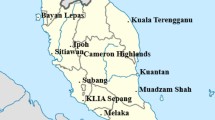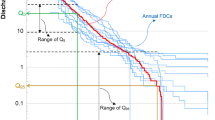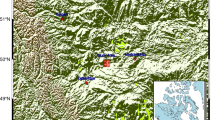Abstract
Manning’s roughness coefficient (\(n\)) is a comprehensive indicator of flow resistance, and significantly affects the accuracy of one-dimensional (1D) unsteady flow simulations. Most previous studies on roughness inversion have focused on the variation of the \(n\) values along the reach—the variations of \(n\) with the discharge or water stage have seldom been investigated. To address this issue, an optimization model based on an adaptive parallel genetic algorithm (APGA) is proposed. This model enables better estimations of \(n\) in 1D unsteady flow simulations by considering the effects of both distance and discharge on \(n\). The objective of the proposed model is to determine the optimal \(n\) values under different discharge strata for every sub-reach by minimizing the discrepancies between the simulated and measured water elevations and discharges. Moreover, a successive-approximation-based stepwise optimizing (SABSO) strategy is developed to improve the performance of the APGA-based optimization model in long natural rivers. The proposed model is evaluated through a case study on the upper reaches of the Yangtze River, China, and compared with models where the \(n\) values are considered to vary with distance or discharge. The results show that the APGA with the SABSO strategy yields better solutions than the APGA alone, and that the proposed model outperforms models that do not consider variations of \(n\) with both discharge and distance. This research provides a novel approach for the inverse estimation of roughness in long river flows.








Similar content being viewed by others
Availability of Data and Materials
The data supporting the findings of this study are available from the corresponding author by request.
References
Agresta A, Baioletti M, Biscarini C et al (2021) Using optimisation meta-heuristics for the roughness estimation problem in river flow analysis. Appl Sci 11:10575. https://doi.org/10.3390/app112210575
Attari M, Hosseini SM (2019) A simple innovative method for calibration of Manning’s roughness coefficient in rivers using a similarity concept. J Hydrol 575:810–823. https://doi.org/10.1016/j.jhydrol.2019.05.083
Attari M, Taherian M, Hosseini SM et al (2021) A simple and robust method for identifying the distribution functions of Manning’s roughness coefficient along a natural river. J Hydrol 595:125680. https://doi.org/10.1016/j.jhydrol.2020.125680
Ayvaz MT (2013) A linked simulation–optimization model for simultaneously estimating the Manning’s surface roughness values and their parameter structures in shallow water flows. J Hydrol 500:183–199. https://doi.org/10.1016/j.jhydrol.2013.07.019
Ayvaz MT, Genç Ö (2012) Optimal estimation of Manning’s roughness in open channel flows using a linked simulation-optimization model. In International Conference on Water, Climate and Environment. Ohrid
Baltzer RA, Lai C (1968) Computer simulation of unsteady flows in waterways. J Hydraul Div 94:1083–1120. https://doi.org/10.1061/JYCEAJ.0001842
Becker L, Yeh WWG (1972) Identification of parameters in unsteady open channel flows. Water Resour Res 8:956–965. https://doi.org/10.1029/WR008i004p00956
Becker L, Yeh WWG (1973) Identification of multiple reach channel parameters. Water Resour Res 9:326–335. https://doi.org/10.1029/WR009i002p00326
Boulomytis VTG, Zuffo AC, Dalfré Filho JG, Imteaz MA (2017) Estimation and calibration of Manning’s roughness coefficients for ungauged watersheds on coastal floodplains. Int J River Basin Manag 15:199–206. https://doi.org/10.1080/15715124.2017.1298605
Bray DI (1979) Estimating average velocity in gravel-bed rivers. J Hydraul Div 105:1103–1122. https://doi.org/10.1061/JYCEAJ.0005270
Chow VT (1959) Open-channel hydraulics. McGraw-Hill, New York
Coon WF (1998) Estimation of roughness coefficients for natural stream channels with vegetated banks. U.S. Geological Survey
Cunge JA, Holly FM, Verwey A (1980) Practical aspects computational river hydraulics. Pitman Publishin, London
Ding Y, Jia Y, Wang SSY (2004) Identification of Manning’s roughness coefficients in shallow water flows. J Hydraul Eng 130:501–510. https://doi.org/10.1061/(ASCE)0733-9429(2004)130:6(501)
Ding Y, Wang SSY (2005) Identification of Manning’s roughness coefficients in channel network using adjoint analysis. Int J Comut Fluid Dyn 19:3–13. https://doi.org/10.1080/10618560410001710496
Dubreuil M, Gagne C, Parizeau M (2006) Analysis of a master-slave architecture for distributed evolutionary computations. IEEE Trans Syst Man Cybern Part B (Cybern) 36:229–235. https://doi.org/10.1109/TSMCB.2005.856724
Fard RS, Heidarnejad M, Zohrabi N (2013) Study factors influencing the hydraulic roughness coefficient of the Karun River (Iran). Int J Farm All Sci 976–981
Fread DL, Smith GF (1978) Calibration technique for 1-D unsteady flow models. J Hydraul Div 104:1027–1044. https://doi.org/10.1061/JYCEAJ.0005026
Goldberg DE (1989) Genetic algorithms in search, optimization and machine learning, 1st edn. Addison-Wesley Longman Publishing Co., Inc, USA
Green JC (2006) Effect of macrophyte spatial variability on channel resistance. Adv Water Resour 29:426–438. https://doi.org/10.1016/j.advwatres.2005.05.010
Hameed LK, Ali ST (2013) Estimating of manning’s roughness coefficient for Hilla river through calibration using HEC-RAS model. Jordan J Civ Eng 7:44–53
Hsu MH, Fu JC, Liu WC (2006) Dynamic routing model with real-time roughness updating for flood forecasting. J Hydraul Eng 132:605–619. https://doi.org/10.1061/(ASCE)0733-9429(2006)132:6(605)
Jebari K (2013) Selection methods for genetic algorithms. Int J Emerg Sci 3:333–344
Jiang M, Li LX (2010) An improved two-point velocity method for estimating the roughness coefficient of natural channels. Phys Chem Earth 35:182–186. https://doi.org/10.1016/j.pce.2010.03.036
John ZS, Yan HL, Jocelyne MRH, Ming Z (2013) Hydrological characteristics of vegetated river flows: a laboratory flume study. Hydrol Sci J 58:1047–1058. https://doi.org/10.1080/02626667.2013.797580
Julien PY (2002) River mechanics. Cambridge University, U.K.
Khatibi RH, Williams JJR, Wormleaton PR (1997) Identification problem of open-channel friction parameters. J Hydraul Eng 123:1078–1088. https://doi.org/10.1061/(ASCE)0733-9429(1997)123:12(1078)
Khedr A (2016) Automated calibration of real water distribution networks: city X case study. Dissertation, University of Waterloo
Kurnatowski J (2013) Inverse problem for looped river networks – lower oder river case study. Arch Environ Prot 39:105–118. https://doi.org/10.2478/aep-2013-0010
Lei Y, Tang HW, Zhou YL et al (2008) Application of genetic algorithm for back analysis of roughness parameters in river networks. Chin J Hydrodynam 23:20–25. (in Chinese)
Li L, Jun KS (2018) Distributed parameter unsteady flow model for the Han River. J Hydro-Environ Res 21:86–95. https://doi.org/10.1016/j.jher.2018.08.004
Liggett JA, Cunge JA (1975) Numerical methods of unsteady flow equations. in: unsteady flow in open channels. Water Resources Publications, Fort Collins, Colorado, p 149
Mavrommatis A, Christodoulou G (2022) Comparative experimental study of flow through various types of simulated vegetation. Environ Process 9:33. https://doi.org/10.1007/s40710-022-00576-w
Mizanur Rashid RSM, Hanif Chaudhry M (1995) Flood routing in channels with flood plains. J Hydrol 171:75–91. https://doi.org/10.1016/0022-1694(95)02693-J
Mohammadi S, Kashefipour SM (2014) Numerical modeling of flow in Riverine basins using an improved dynamic roughness coefficient. Water Resour 41:412–420. https://doi.org/10.1134/S0097807814040149
Nguyen HT, Fenton JD (2004) Identification of roughness in open channels. Int Conf Hydro-Sci Eng
Nguyen HT, Fenton JD (2005) Identification of roughness for flood routing in compound channels. Congress Int Assoc Hydraul Eng Res 1–9
Niazkar M, Talebbeydokhti N, Afzali SH (2019) One dimensional hydraulic flow routing incorporating a variable grain roughness coefficient. Water Resour Manag 33:4599–4620. https://doi.org/10.1007/s11269-019-02384-8
Ong TDB, Doscher C, Mohssen M (2017) Simulated annealing for calibrating the Manning’s roughness coefficients for general channel networks on a basin scale. Arab J Geosci 10:532. https://doi.org/10.1007/s12517-017-3320-6
Okhravi S, Schügerl R, Velísková Y (2022) Flow resistance in lowland rivers impacted by distributed aquatic vegetation. Water Resour Manag 36:2257–2273. https://doi.org/10.1007/s11269-022-03139-8
Saad M, El-Moursy A, Alfawaz O et al (2021) Wireless link scheduling via parallel genetic algorithm. Concurr Comput 34:e6783. https://doi.org/10.1002/cpe.6783
Siqueira V, Sorribas M, Bravo J et al (2016) Real-time updating of HEC-RAS model for streamflow forecasting using an optimization algorithm. RBRH 21:855–870. https://doi.org/10.1590/2318-0331.011616086
Tang H, Xin X, Dai W, Xiao Y (2010) Parameter identification for modeling river network using a genetic algorithm. J Hydrodyn 22:246–253. https://doi.org/10.1016/S1001-6058(09)60051-2
Urquhart WJ (1975) Hydraulics: Engineering field manual. U.S. Department of Agriculture, Soil Conservation Service, Washington D.C
Wang LL, Zhong N, Cheng GF (2010) Inverse calculation of bed roughness based on singular value decomposition method. J Hohai Univ 81:116–116. (in Chinese)
Wiggert J, Taylor M, Contractor D (1976) Optimization of an implicit flow routing model. In Int Symp Unsteady Flow Open Channels
Yang F, Wu J, Zhang Y et al (2021) Improved method for identifying Manning’s roughness coefficients in plain looped river network area. Eng Appl Comput Fluid Mech 15:94–110. https://doi.org/10.1080/19942060.2020.1858967
Yang XS (2014) Chapter 5 - Genetic Algorithms. In: Yang XS (ed) Nature-Inspired Optimization Algorithms. Elsevier, Oxford, pp 77–87. https://doi.org/10.1016/B978-0-12-416743-8.00005-1
Yen BC (2002) Open channel flow resistance. J Hydraul Eng 128:20–39. https://doi.org/10.1061/(ASCE)0733-9429(2002)128:1(20)
Yu J, Yin Y (2010) Assembly line balancing based on an adaptive genetic algorithm. Int J Adv Manuf Technol 48:347–354. https://doi.org/10.1007/s00170-009-2281-7
Acknowledgements
This work was a result of research supported in part by the National Natural Science Foundation of China (51679088), Project of National Key Research and Development Program of China (2016YFC0402308). We thank Stuart Jenkinson, PhD, from Liwen Bianji (Edanz) (www.liwenbianji.cn/) for editing the English text of a draft of this manuscript.
Funding
This work was a result of research supported in part by the National Natural Science Foundation of China (51679088), Project of National Key Research and Development Program of China (2016YFC0402308).
Author information
Authors and Affiliations
Contributions
All authors contributed to the study’s conception and design. Conceptualization, supervision, editing, and revision were contributed by Yang Peng. Model simulations, code implementation, and original draft writing were performed by Lishuang Yao. Programming and code testing were contributed by Xianliang Yu. Algorithms supporting and data analysis were performed by Zhihong Zhang. Data preparation and visualization were performed by Shiqi Luo. All authors commented on previous versions of the manuscript and approved the final manuscript.
Corresponding author
Ethics declarations
Ethics Approval
Not applicable.
Consent to Participate
Not applicable.
Consent for Publish
Not applicable.
Competing Interests
The authors declare that there is no known conflict of interest to influence the work reported in the submitted manuscript.
Additional information
Publisher's Note
Springer Nature remains neutral with regard to jurisdictional claims in published maps and institutional affiliations.
Rights and permissions
Springer Nature or its licensor (e.g. a society or other partner) holds exclusive rights to this article under a publishing agreement with the author(s) or other rightsholder(s); author self-archiving of the accepted manuscript version of this article is solely governed by the terms of such publishing agreement and applicable law.
About this article
Cite this article
Yao, L., Peng, Y., Yu, X. et al. Optimal Inversion of Manning’s Roughness in Unsteady Open Flow Simulations Using Adaptive Parallel Genetic Algorithm. Water Resour Manage 37, 879–897 (2023). https://doi.org/10.1007/s11269-022-03411-x
Received:
Accepted:
Published:
Issue Date:
DOI: https://doi.org/10.1007/s11269-022-03411-x




